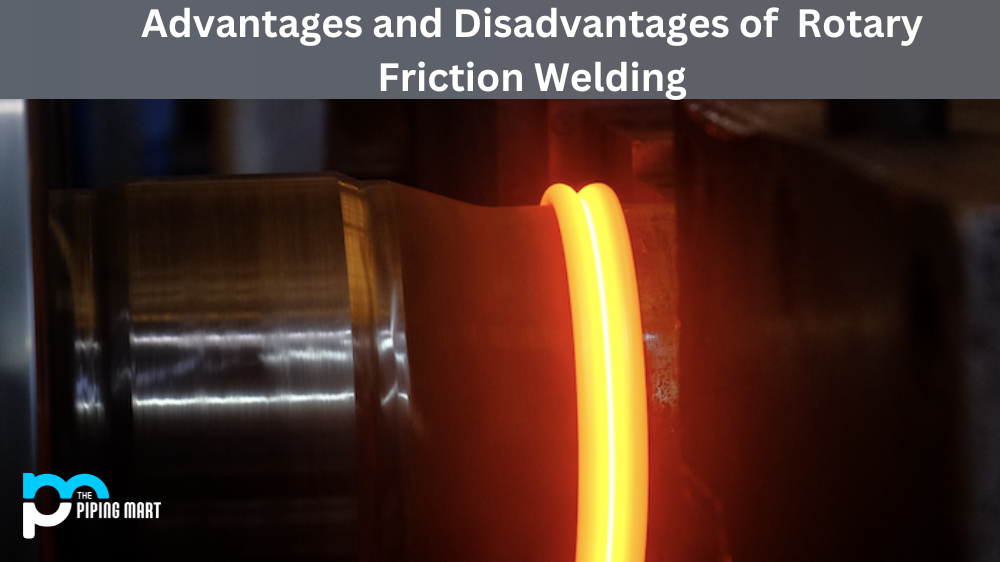Rotary friction welding is a type of welding that is becoming increasingly popular among manufacturers. This welding technique utilizes friction heat generated from rubbing two parts together at high speeds to form a secure joint. While rotary friction welding has many advantages, it is important to understand both the pros and cons to make an informed decision on whether or not this type of welding is right for your project.
Advantages of Rotary Friction Welding
One of the biggest advantages of using rotary friction welding for manufacturing is its speed and efficiency. This welding technique involves spinning one-piece relative to another at high speeds, resulting in very fast welds that are usually completed in just a few seconds. Additionally, since rotary friction welding does not require any additional material, such as flux or filler rods, the process can be more cost-effective than other welding processes. Furthermore, since no additional material is used during the process, there is no need for clean-up after completing the weld.
Another advantage of rotary friction welding is its ability to create strong weld joints with minimal distortion or deformation. Since this type of welding uses high-speed rotation rather than heat to join two pieces together, less heat penetrates the surrounding area, and thus there is less chance for warping or distortion during the process. Additionally, because no additional materials are used in this process, the weld joint created by rotary friction welding will be extremely strong and durable.
- Rotary friction welding is a solid-state joining process that produces the coalescence of materials without molten filler metal.
- RFW can join various dissimilar materials, including metals, plastics, and composites.
- RFW is a relatively fast process, with weld times typically in the range of seconds to minutes.
- RFW is a versatile process that can be used to join parts of various shapes and sizes.
- RFW can be performed using automated equipment, which reduces the potential for operator error and increases productivity.
Disadvantages of Rotary Friction Welding
Despite having many advantages over other types of welding processes, rotary friction welding also has some drawbacks that should be considered when deciding whether or not it’s suitable for your project. One major disadvantage is that due to its complexity and specialized nature, this type of welding requires highly skilled technicians who have extensive knowledge about properly operating the equipment needed for this process. In addition, due to its relatively high cost and specialized nature, it may not be feasible for smaller projects where cost and time are primary concerns. Finally, since this type of welding requires very precise alignment between two pieces being joined together at high speeds, any misalignment can lead to poor quality welds and even complete joint failure if not corrected quickly enough by an experienced technician.
Limited to cylindrical shapes
One of the primary disadvantages of rotary friction welding is that it is limited to cylindrical shapes. This means it cannot be used to weld other shapes, such as square or rectangular tubing. Additionally, rotary friction welding can only be used on materials that can withstand the high temperatures generated by the welding process.
Requires special fixtures
Another disadvantage of rotary friction welding is that it requires special fixtures to hold the materials in place during the welding process. These fixtures can be expensive, which can add to the overall cost of the welding process. Additionally, the fixtures must be carefully designed to ensure that the welded materials are held securely and will not slip during the welding process.
Materials must be clean.
Another disadvantage of rotary friction welding is that the welded materials must be clean for the weld to be strong. Any dirt, grease, or other contaminants on the material’s surface can weaken the weld or cause it to fail completely. This means extra time and effort must be expended to clean the materials before welding.
Heat-sensitive materials can be damaged.
Rotary friction welding can also damage heat-sensitive materials if they are not carefully monitored during the welding process. The high temperatures generated by the welding process can cause these materials to warp or melt if they are not kept at a consistent temperature. This can lead to problems with the finished product, such as uneven surfaces or weak areas.
Requires skilled operator
Finally, rotary friction welding requires a skilled operator to produce quality welds. The operator must understand the welding process and how to set up and operate the equipment properly. Additionally, the operator must be able to troubleshoot any problems during the welding process.
Conclusion:
Rotary friction welding offers many advantages over other types of joining methods, including speed and efficiency and minimal distortion or deformation during the process due to lack of heat penetration into surrounding areas. However, it’s essential to consider its advantages and disadvantages before deciding whether it’s suitable for your project. An experienced technician knowledgeable about operating specialized equipment will be key when utilizing this method to get optimal results while still maintaining cost effectiveness and time savings benefits provided by rotary friction welding technology.

Abhishek is a seasoned blogger and industry expert, sharing his insights and knowledge on various topics. With his research, Abhishek offers valuable insights and tips for professionals and enthusiasts. Follow him for expert advice on the latest trends and developments in the metal industry.




